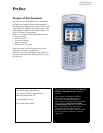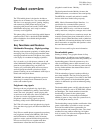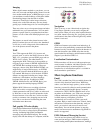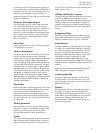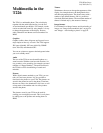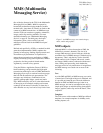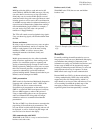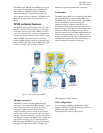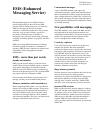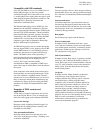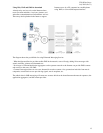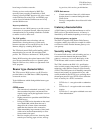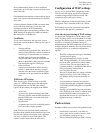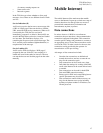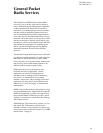T226 White Paper
July 2003 (Rev C)
11
EMS (Enhanced
Messaging Service)
Enhanced Messaging Service (EMS) adds new
powerful functionality to the well-known SMS
standard. With it, mobile phone users can add life to
SMS text messaging in the form of pictures,
animations, sound and formatted text. This gives the
users new ways to express feelings, moods and
personality in SMS messages. In addition to
messaging, users will enjoy downloading, collecting,
swapping, and editing pictures, ring signals, and other
melodies.
EMS uses existing SMS infrastructure and industry
standards, keeping investments to a minimum for
operators. EMS provides a familiar user interface and
compatibility with existing phones and other
manufacturers.
EMS – more than just words
Sounds and melodies
EMS gives the user the ability to send and receive
sounds. These can be pre-defined sounds or melodies
(ring signals in the phone), downloaded from the
Internet, received in SMS messages or composed by
the user on the phone keypad or a PC. Note that MIDI
ring signals cannot be exchanged via EMS.
Several sounds and melodies can be inserted in one
message, and they can be combined with pictures.
Pictures, animations and formatted text
Phones supporting EMS include a set of pre-defined
pictures for inserting in SMS messages. New pictures
and animations are downloaded from the Internet or
received in SMS messages. Several pictures can be
inserted in one message, and they can be combined
with sounds and melodies. The users can format text in
messages with different styles and sizes.
Concatenated messages
A part of the EMS standard is the support for
concatenated messages, which means that the phone is
able to automatically combine several messages both
when creating and receiving EMS. This is useful to be
able to build, and display, messages with rich content,
since the amount of information in each SMS is limited
by the SMS standards.
New possibilities with messaging
The EMS standard is now a part of the SMS standard
and supported by the major network operators and
mobile phone manufacturers. This universal approach
enables a fast penetration and development of new
services and applications within messaging.
Creativity explosion
Users will be inspired to create and swap their own
melodies and pictures. But more importantly,
professional content creators and providers are already
preparing to offer imaginative and creative contents for
use with EMS. Based on subscriptions, fees or ads,
network operators will be able to provide wide ranges
of ring signals, operator logos and corporate icons, as
well as personal and mood-related pictures and
melodies. Movie, music and game companies can
promote new products and events with designer
melodies, animations and pictures.
Huge business potential
Network operators can now enhance their services and
attract more customers by offering pictures,
animations, ring signals and melodies for download at
their portals. Operators can charge more per EMS
message since it contains more data. Thereby EMS
adds more value to the operators and to the end users.
Increase SMS revenue
EMS uses the same basic network support as ordinary
SMS, and with the same familiar user interface. From
an operator's point of view, SMS is low tech because
minimal investment is needed to provide an effective
SMS service to subscribers and little maintenance is
required. EMS will create additional revenue for
service providers and network operators by increasing
SMS traffic.



